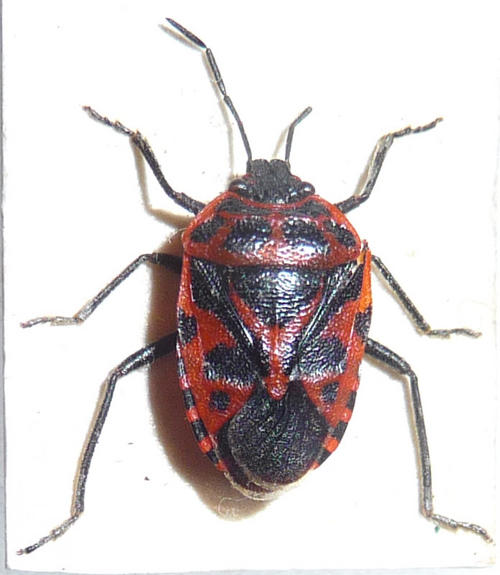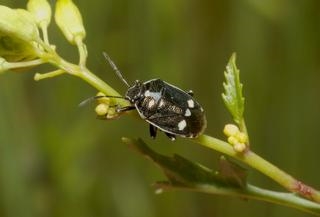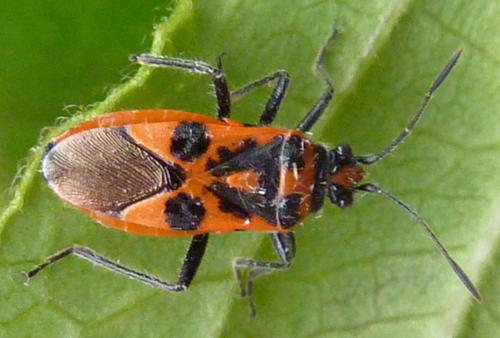Striking red and black bugs (Hemiptera - Heteroptera) in Worcestershire
John Meiklejohn
(There is an increasing number of sightings of striking red and black bugs in Worcestershire. Hopefully this article will encourage readers to look out for them and send in records. Ed.)
Eurydema ornata (Fig. 1.)
In March 2000 I was given a striking red and black coloured shield bug that had emerged from purchased broccoli in a house in Westmancote, on the southern slope of Bredon Hill. Using P.Kirby’s Draft Key for British Heteroptera, it was identified as Eurydema ornata. The British Bugs website states: a relatively recent arrival in the UK, but now established in the Channel Isles, and in Dorset and Hampshire; it may also appear at other places in south England. It spends the winter as an adult and feeds on crucifers, including cress, radish and cabbages.
Eurydema dominulus is very similar to and slightly smaller than E. ornata. It lacks the dark spot on the embolium of the wing. There are a few U.K. records for this species, mainly from Kent and Sussex. The British Bugs website states: a very scarce species found in woodland rides in parts of southern England. Most records are from Kent and Sussex.
Eurydema oleracea (Fig.2.)
In June 2005, whilst with a party from the South-east Worcestershire local group of the Worcestershire Wildlife Trust in the Umbria region of Italy, I collected another brightly coloured, red and black shield bug. This was determined as Eurydema oleracea, the Brassica Bug, a bug associated with cruciferous plants, particularly with Horse-radish, Armorica rusticana. The form with the red markings is less common than the form with white markings. There are records in Worcestershire Biological Records Centre for this bug from John Partridge, 2004, and Kevin McGee (2007). Kevin published the picture (Fig. 2) and wrote as follows: The Brassica Bug. My first UK records for this mainly southern species were both from Oilseed Rape flowers near Deerfold Wood, Drakes Broughton on 5.5.2007 & 20.5.2007.
The British Bugs website states: well distributed in southern and central England; may be locally frequent and appears to be increasing in abundance.
Corizus hyoscyami (Fig. 3).
Another similarly coloured bug which is becoming more common than the above species is the rhopalid bug Corizus hyoscyami. It has spread from the south-west of England where it was first recorded and was first found in Worcestershire in the Redditch area in 2006 by Gary Farmer. It is a polyphagus species and known to feed on Storksbills. There are five Worcestershire records for it in Worcestershire Biological Records Centre. The British Bugs website states: locally distributed in sandy habitats around the coasts of southern Britain, this species has recently been found more frequently inland. It is associated with a range of plants, and overwinters as an adult, the new generation appearing in August-September. Nymphs are yellow/red-brown in colour and also rather hairy.
McGee (2007) also wrote as follows: Corizus hyoscyami (Rhopalidae, local). One of these striking red & black bugs was found on ground vegetation in the garden of ‘The Newalls’ at the Wyre Forest by John Partridge at the end of a Wyre Forest Study Group field trip on 21.4.2007. Just as I was about to take a photo it took flight and was not relocated! Please also see page 41 of the November 2006 issue of the Worcestershire Record for previous reports of this species which is yet another spreading up from the south.
Pyrrhocoris apterus
A red and black bug that has to date only been regularly recorded from a rock off the coast of South Devon but is common in Europe is the Red Fire Bug, Pyrrhocoris apterus. It can easily be confused with Corizus hyosciami but as it is associated with Tree Mallow it is unlikely to turn up in Worcestershire.
References
The British Bugs web site is a useful source of information and pictures: http://www.britishbugs.org.uk.
Evans, M & Edmondson, R. 2005. A photographic guide to the Shieldbugs and Squashbugs of the British Isles. Published by WGUK in association with WildGuideUK.com.
McGee, K 2007. Records of Note 2007. Worcestershire Record 23:42-46.
Images
Fig.1. John Meiklejohn’s specimen of Eurydema ornata. Picture ©Harry Green.
Fig.2. Eurydema oleracea. The white and black form with red marks replaced by white. Picture ©Kevin McGee.
Fig.3. Corizus hyoscyami at Grafton Wood 3rd January 2011. Picture ©Tony Simpson.


